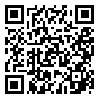BibTeX | RIS | EndNote | Medlars | ProCite | Reference Manager | RefWorks
Send citation to:
URL: http://jdisabilstud.org/article-1-2928-en.html
2- Associate Professor in Psychology, Payame Noor University, Tehran, Iran
3- Assistant Professor, Department of Psychology, Shahroud Branch, Islamic Azad University, Shahrood, Iran
Background & Objectives: Obsessive–compulsive disorder is diagnosed based on the presence of unwanted and disturbing thoughts and repetitive behaviors. A person suffering from obsessive–compulsive disorder shows disorders in executive functions, such as psychological flexibility, prevention from the occurrence of response, defects in visual and verbal memory and emotional processing. Cognitive flexibility is an important aspect of executive function, defined as the ability to adapt efficiently to changing demands. Research evidence shows that obsessive–compulsive disorder can affect the indecisiveness of patients. It indicates that obsessive people use a mechanism for ambiguity and potentially threatening stimuli, as well as for achieving a sense of control over stimuli. Harassers engage in behaviors that provoke ambiguity or uncertainty. One of the treatments whose effectiveness has been confirmed in psychological disorders is coping therapy. Therefore, this research aimed to determine the effectiveness of cognitive coping therapy on ambiguity tolerance and cognitive flexibility in people with obsessive–compulsive disorder.
Methods: The current research was quasi–experimental with a pretest–posttest design and a control group. The statistical population included people with obsessive–compulsive symptoms in the vocational training and occupational therapy camp of Semnan City, Iran, in 2021. Among the statistical population, 30 qualified volunteers were randomly entered into the study and assigned to experimental and control groups (each group included 15 people). The implementation method was such that after selecting the people of the sample group and before starting the treatment program, theAmbiguity Tolerance Questionnaire (McLain, 1993) and Acceptance and Action Questionnaire–II (Bond et al., 2011) were distributed between both groups. After that, the therapy intervention program was implemented in the experimental group (in the form of 14 90–min sessions, one session per week) and the control group was not subjected to any treatment program. In the end, the posttest was done again from both groups by the mentioned questionnaires. Also, after the research, to maintain the ethical standards, the treatment programs were implemented in the control group. The inclusion criteria were as follows: being interviewed based on DSM–5 criteria and also a higher than average score on the Yale–Brown Obsessive Compulsive Scale (Y–BOCS) (because the statistical population of this research comprised people with obsessive symptoms) which was carried out by a specialist in the field of clinical psychology, having at least a diploma level of education, not participating in other psychological interventions at the same time, lacking any debilitating physical and mental diseases diagnosed by the researcher using a clinical interview. The exclusion criteria were as follows: absence of more than three sessions, non–observance of group–therapy rules, and suffering from a physical or mental illness that did not exist before the treatment and was identified during the implementation. Data analysis was carried out in two parts: descriptive statistics and inferential statistics. At the level of descriptive statistics, frequency, percentage, mean and standard deviation were used, and at the level of inferential statistics, multivariate covariance analysis was performed. Data analysis was done in SPSS software version 24 and the significance level of the tests was considered to be 0.05.
Results: The findings showed the significant (p<0.001) effect of cognitive coping therapy on ambiguity tolerance and cognitive flexibility in people with obsessive–compulsive disorder.
Conclusion: According to the findings, coping therapy focuses on the individual's coping style rather than directly affecting the tolerance of ambiguity and cognitive flexibility of obsessive–compulsive individuals. Also in the long term, by influencing these coping methods, it can affect tolerance ambiguity and cognitive flexibility.
| Rights and permissions | |
 |
This work is licensed under a Creative Commons Attribution-NonCommercial 4.0 International License. |



